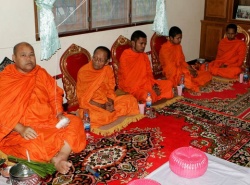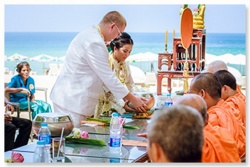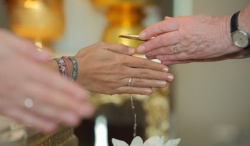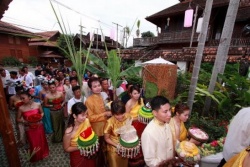Traditional Buddhist Wedding Ceremony
The Buddhist religion is known for being simple and this is often reflected in their wedding ceremonies. The Buddha did not consider marriage to be a sacred ceremony; therefore it is a more social event rather than a religious occasion. Buddhist weddings also do not contain any complex rituals that might be seen in other religious wedding ceremonies. A Buddhist wedding ceremony is meant to symbolize the compromise of the companionship between two people. It is a marriage based on spiritual faith and not centered on religion, where both couples sincerely vow to maintain a harmonious and spiritually sound relationship.
More than anything, a marriage to Buddhists is based on faith and belief. They believe that life is a continuing process of change and that you should always be moving towards a state of greater wisdom and awareness. The couple makes a commitment and sincere effort to create a harmonious relationship together. There are no religious or mandatory rules that the couple must follow. The entire marriage ceremony is treated more like a social affair.
Buddhist marriage is quite a boisterous affair, wherein the boy’s family arrives at the girl’s place. The custom has it that a pot of water, flowers, bamboo sticks are arranged in a typical way and leaves adorn the entrance for good luck.
A couple’s ethnic backgrounds determine what type of wedding ceremony that will happen to vow their eternal love to each other. And while many couples who choose to wed in Thailand may not come from a Buddhist upbringing, many embrace the tranquility of this spiritual religion and incorporate one or several elements of a Buddhist wedding into their special day.
One tradition that a Buddhist wedding can include are for one, visiting a lama (a Buddhist priest) who can help the groom figure out whether his and the bride’s horoscopes are a match for getting married. This helps the groom plan what day is spiritual for proposing to the bride.
The ceremony consists of two parts, one being Buddhist, the other is a non-Buddhist. The non-Buddhist part of the ceremony is all the traditional practices the family follows which may include a feast or gift exchange. During the Buddhist component, prayers are offered along with gifts to the almighty (God) and monks. This is also when the couple
takes vows of faithfulness to each other. They choose which scriptures to read as well as what other traditions they would like to take part in. One Buddhist tradition is that both the bride and groom walk down the aisle carrying 21 strands of beads each. This strand is called the o juju and is much like a Catholic rosary. This strand however is shorter and represents Buddha, the couple and their families.
On the night before the wedding day, there is a traditional Buddhist ceremony. During this, the newlyweds pay honor and tribute to the bride’s ancestors. Nine monks are invited and the newlyweds sit in front of an altar. A sacred thread joins the heads of the groom and bride and is then unrolled into the monk’s hands. Near the first monk there is a
bowl with a candle and water inside. This is used as holy water for the next day. One monk holds a fan in one hand and a microphone in the other hand. The whole village can listen to the prayers being said in honor of the couple. After the end of the prayers they go back to the temple. A traditional vow goes as follows: The groom will say, “Towards my
wife I undertake to love and respect her, be kind and considerate, be faithful, delegate domestic management and present gifts to please her.” The bride will then say, “Towards my husband I undertake to perform my household duties efficiently, be hospitable to my in-laws and friends of my husband, be faithful, protect and invest our earnings and discharge my responsibilities lovingly and fastidiously.”
On the morning of the wedding day, the monks arrive at the temple and prayers are said as holy water is thrown on guests. The string is on the couple’s head again which makes a circle around them. Nine trays are placed in front of the monks. Each tray contains several small dishes. After prayers are over, the newlyweds give an envelope to each monk. The envelopes contain money. As monks cannot touch money, Thai people give envelopes. Then monks eat and when meal is over they go back to the temple.
Some Buddhist temples are licensed as official marriage venues; otherwise a couple could choose a civil ceremony followed by a blessing at a temple. The format of the ceremony will depend on the couple’s own choice and the customs of the country it’s performed in as no restrictions have been laid down by Buddhism.
There are no rules regarding official attire to be worn for the ceremonies. The bride must choose a gown that is not too revealing and the groom wears a suit, and can choose to wear the official dress of their region or country. For guests, if the ceremony is conducted in a temple, guests should also remember that according to tradition they will need to remove their shoes before entering the shrine room where the blessing will be held.
Music and dancing is a large part of the reception ceremony. Traditional dances are performed including the women who have an independent folk dance. For the cuisine, the main beef dishes are pork and beef along with a side dish of rice. Buddhists traditionally go for the oriental dishes, so they are generally steamed or roasted.
A Buddhist wedding stays true to what they are all about, and that is staying simple. By having a simple wedding, this culture allows themselves to focus on the most important aspect of the day; the couple and the love they share.




